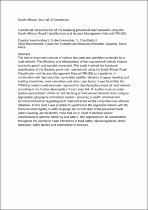 ResearchSpace
ResearchSpace
Functional classification of the Gauteng provincial road network using the South African road classification and access management manual (TRH26)
JavaScript is disabled for your browser. Some features of this site may not work without it.
- ResearchSpace
- →
- Research Publications/Outputs
- →
- Journal Articles
- →
- View Item
| dc.contributor.author |
Veramoothea, P

|
|
| dc.contributor.author |
Breytenbach, Andre

|
|
| dc.contributor.author |
Baloyi, E

|
|
| dc.date.accessioned | 2016-10-13T13:40:37Z | |
| dc.date.available | 2016-10-13T13:40:37Z | |
| dc.date.issued | 2015-08 | |
| dc.identifier.citation | Veramoothea, P., Breytenbach, A. and Baloyi, E. 2015. Functional classification of the Gauteng provincial road network using the South African road classification and access management manual (TRH26). South African Journal of Geomatics, 4(3), pp 264-272 | en_US |
| dc.identifier.issn | 2225-8531 | |
| dc.identifier.uri | http://www.sajg.org.za/index.php/sajg/article/view/307 | |
| dc.identifier.uri | http://hdl.handle.net/10204/8830 | |
| dc.description | Copyright: 2015 CONSAS Conference. This is an abstract of the article. The definitive version of the work is published in the South African Journal of Geomatics, Vol 4(3), pp 264-272 | en_US |
| dc.description.abstract | The built environment consists of various land uses and activities connected by a road network. The efficiency and effectiveness of the road network directly impacts economic growth and societal movement. This study involved the functional classification of the Gauteng provincial road network using the South African Road Classification and Access Management Manual (TRH26) as a guideline. In combination with high resolution up-to-date satellite reference imagery, dwelling and building inventories, road centrelines and other base layers, it was found that the TRH26 provided a well-structured approach to classifying the provincial road network according to the functional properties of each road link. It resulted in an accurate spatial representation of the current Gauteng provincial road network when using an appropriate geographic information system - providing a wealth of formal and technical information regarding each road and street via the comprehensive attribute database. At link level it was possible to synchronise the upgraded network with the financial asset registry in order to gauge the current state of the provincial roads within Gauteng, and to identify those that are in need of attention and/or rehabilitation to optimise efficiency and safety. This approach can be standardised throughout the country to make inferences to road safety, speed regulation, driver behaviour, traffic studies and accessibility to services. | en_US |
| dc.language.iso | en | en_US |
| dc.publisher | CONSAS Conference | en_US |
| dc.relation.ispartofseries | Worklist;15579 | |
| dc.subject | South African Road Classification and Access Management Manual | en_US |
| dc.subject | TRH26 | en_US |
| dc.subject | Road networks | en_US |
| dc.subject | Geographic information systems | en_US |
| dc.subject | GIS | en_US |
| dc.title | Functional classification of the Gauteng provincial road network using the South African road classification and access management manual (TRH26) | en_US |
| dc.type | Article | en_US |
| dc.identifier.apacitation | Veramoothea, P., Breytenbach, A., & Baloyi, E. (2015). Functional classification of the Gauteng provincial road network using the South African road classification and access management manual (TRH26). http://hdl.handle.net/10204/8830 | en_ZA |
| dc.identifier.chicagocitation | Veramoothea, P, Andre Breytenbach, and E Baloyi "Functional classification of the Gauteng provincial road network using the South African road classification and access management manual (TRH26)." (2015) http://hdl.handle.net/10204/8830 | en_ZA |
| dc.identifier.vancouvercitation | Veramoothea P, Breytenbach A, Baloyi E. Functional classification of the Gauteng provincial road network using the South African road classification and access management manual (TRH26). 2015; http://hdl.handle.net/10204/8830. | en_ZA |
| dc.identifier.ris | TY - Article AU - Veramoothea, P AU - Breytenbach, Andre AU - Baloyi, E AB - The built environment consists of various land uses and activities connected by a road network. The efficiency and effectiveness of the road network directly impacts economic growth and societal movement. This study involved the functional classification of the Gauteng provincial road network using the South African Road Classification and Access Management Manual (TRH26) as a guideline. In combination with high resolution up-to-date satellite reference imagery, dwelling and building inventories, road centrelines and other base layers, it was found that the TRH26 provided a well-structured approach to classifying the provincial road network according to the functional properties of each road link. It resulted in an accurate spatial representation of the current Gauteng provincial road network when using an appropriate geographic information system - providing a wealth of formal and technical information regarding each road and street via the comprehensive attribute database. At link level it was possible to synchronise the upgraded network with the financial asset registry in order to gauge the current state of the provincial roads within Gauteng, and to identify those that are in need of attention and/or rehabilitation to optimise efficiency and safety. This approach can be standardised throughout the country to make inferences to road safety, speed regulation, driver behaviour, traffic studies and accessibility to services. DA - 2015-08 DB - ResearchSpace DP - CSIR KW - South African Road Classification and Access Management Manual KW - TRH26 KW - Road networks KW - Geographic information systems KW - GIS LK - https://researchspace.csir.co.za PY - 2015 SM - 2225-8531 T1 - Functional classification of the Gauteng provincial road network using the South African road classification and access management manual (TRH26) TI - Functional classification of the Gauteng provincial road network using the South African road classification and access management manual (TRH26) UR - http://hdl.handle.net/10204/8830 ER - | en_ZA |





